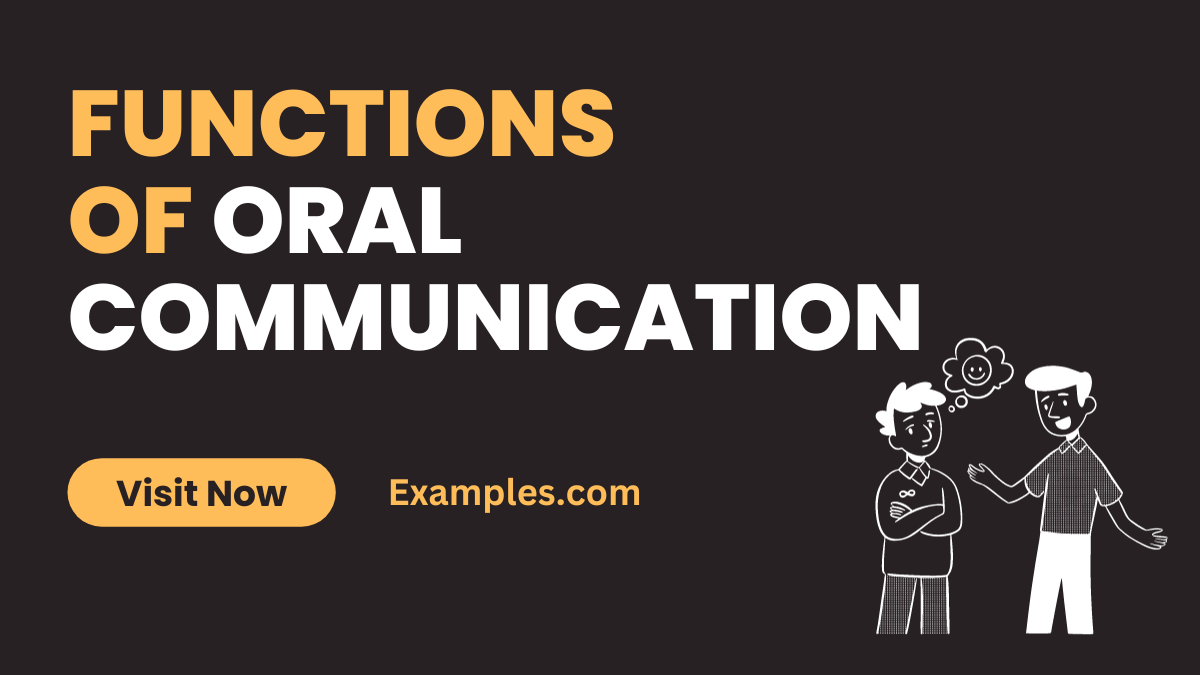29+ Functions of Oral Communication Examples
Understanding the Functions of Oral Communication is crucial for effective personal and professional interactions. This complete guide delves into the core aspects such as active listening, feedback, and the art of storytelling in Oral Communication. It explores how these functions facilitate clear understanding, foster relationships, and enhance information dissemination. Whether it’s in the workplace or daily life, mastering these functions is key to effective verbal exchanges and meaningful connections.
30 Functions of Oral Communication

Oral communication serves multiple functions, facilitating effective interpersonal interactions and information exchange. It encompasses active listening, ensuring mutual understanding, and confidence in oral communication, enhancing message delivery. These functions include expressing thoughts, sharing knowledge, influencing decisions, and building relationships. Effective oral communication enhances clarity and fosters trust, critical in personal and professional settings.
1. Information Sharing
Information sharing through oral communication is fundamental in various contexts. It involves conveying facts, data, or opinions from one person to another or to a group. Effective information sharing requires clarity, conciseness, and relevance to the audience. It’s essential in workplaces, educational settings, and personal interactions for clear understanding and efficient knowledge transfer.
Example: During a company meeting, a project manager uses clarity in Oral Communication to explain the upcoming project phases to the team. The manager details each step, ensuring everyone understands their roles and deadlines. The team members, actively listening, ask clarifying questions, ensuring complete understanding of the information shared.
2. Instruction Giving
Instruction giving is a critical function of oral communication, especially in educational and professional settings. It involves clearly and effectively conveying steps, guidelines, or methods to complete a task or understand a concept. Successful instruction giving requires the speaker to be clear, concise, and considerate of the audience’s knowledge level.
Example: In a cooking class, the chef uses storytelling in Oral Communication to explain the recipe. The chef narrates each step vividly, demonstrating techniques while maintaining eye contact with the students. The students, engaged and attentive, follow the instructions, replicating the cooking process.
3. Feedback Receiving
Receiving feedback through oral communication is crucial for personal and professional growth. It involves actively listening to and processing critiques or suggestions from others. Constructive feedback should be given respectfully and received with an open mind, facilitating improvement and learning.
Example: An employee sits down with their supervisor for a performance review. The supervisor provides constructive feedback, highlighting areas of strength and improvement. The employee listens attentively, acknowledges the feedback, and discusses ways to enhance performance, demonstrating active listening in Oral Communication.
4. Problem-Solving
Oral communication is integral to problem-solving, especially in collaborative environments. It involves discussing issues, brainstorming ideas, and deliberating on solutions. Effective problem-solving communication requires open-mindedness, clarity, and a willingness to consider multiple perspectives. It’s vital in business, academic settings, and personal situations where collective input can lead to innovative solutions.
Example: A team of engineers meets to address a technical challenge in their project. Each member presents different solutions, engaging in healthy debate and questioning in Oral Communication. Their collaborative discussion leads to a creative solution that combines various ideas, showcasing the power of collective problem-solving through effective communication
5. Decision Making

Decision making through oral communication is a process where individuals or groups discuss options and reach a conclusion. It’s crucial in settings where joint consensus is needed. Effective decision-making communication requires a clear presentation of options, understanding the implications, and considering diverse viewpoints.
Example: A family gathers to decide on their next vacation destination. They discuss various locations, considering each member’s preferences and concerns. The discussion is marked by active listening in Oral Communication, as each member’s opinion is valued, leading to a unanimous decision that satisfies everyone.
6. Persuasion
Persuasion in oral communication is the ability to influence others’ thoughts or actions. It’s used in marketing, sales, politics, and personal interactions. Effective persuasion combines logical argumentation, emotional appeal, and credibility. It requires understanding the audience’s values and presenting arguments in a compelling manner.
Example: A salesperson presents a new product to potential clients. They skillfully blend facts about the product’s benefits with stories of satisfied customers, employing confidence in Oral Communication. Their convincing and engaging presentation persuades several clients to make a purchase.
7. Conflict Resolution
Conflict resolution through oral communication involves addressing disagreements and finding amicable solutions. It’s essential in maintaining healthy relationships in personal and professional spheres. Effective conflict resolution requires empathy, active listening, and non-confrontational dialogue to understand different perspectives and reach a mutually acceptable solution.
Example: Two coworkers disagree on a project approach. They hold a meeting to discuss their viewpoints, each articulating their concerns and suggestions. Through active listening in Oral Communication and respectful dialogue, they find a compromise that incorporates both their ideas.
8. Building Relationships
Building and maintaining relationships through oral communication is key in personal, social, and professional life. It involves sharing experiences, expressing emotions, and offering support. Effective relationship-building communication is characterized by empathy, sincerity, and open, honest dialogue.
Example: Regular coffee meetups between colleagues where they share personal stories and professional experiences. These interactions, marked by genuine interest and understanding in Oral Communication, strengthen their bond and enhance workplace collaboration.
9. Emotional Expression
Expressing emotions through oral communication allows individuals to share their feelings, thoughts, and experiences. It’s essential for emotional well-being and building deeper connections with others. Effective emotional expression involves honesty, vulnerability, and the ability to articulate feelings clearly.
Example: A person shares their feelings with a close friend after a challenging day. The conversation, filled with genuine emotion and active listening in Oral Communication, helps them feel understood and supported, deepening the friendship.
10. Entertainment
Oral communication serves an entertainment function through storytelling, jokes, or theatrical performances. It provides enjoyment, relaxation, and cultural enrichment. Effective entertainment communication captivates the audience, evoking emotions and often conveying underlying messages or morals.
Example: A stand-up comedian performs at a club, delivering jokes and anecdotes. Their timing, expression, and storytelling in Oral Communication keep the audience engaged and amused, showcasing the power of oral communication in entertainment.
11. Cultural Transmission

Oral communication is vital for cultural transmission, passing down traditions, values, and beliefs through stories, myths, and teachings. It helps preserve cultural heritage and fosters a sense of identity and community. Effective cultural transmission involves engaging storytelling and respect for historical context and values.
Example: During a cultural festival, elders narrate folklore and legends to the younger generation. Their vivid storytelling and emphasis on moral lessons, demonstrating storytelling in Oral Communication, help preserve and transmit cultural values.
12. Motivation
Oral communication in motivation involves inspiring and encouraging others through words. It’s crucial in leadership, coaching, and personal development. Effective motivational communication uplifts, energizes, and drives people towards goals, often combining emotional appeal with practical advice.
Example: A sports coach gives an inspiring talk before a big game, focusing on the team’s strengths and past achievements. Their confidence in Oral Communication and motivational words boost the team’s morale and readiness for the challenge.
13. Education
Oral communication is foundational in education, facilitating knowledge transfer, discussions, and intellectual development. Effective educational communication requires clarity, engagement, and adaptability to students’ learning styles and needs.
Example: In a classroom, a teacher leads a discussion on a historical event. They encourage students to express their viewpoints, fostering critical thinking and active listening in Oral Communication, which enhances the learning experience.
14. Negotiation
Negotiation through oral communication involves discussing terms and conditions to reach a mutual agreement. It’s key in business, legal, and personal scenarios. Effective negotiation requires clear articulation of needs, understanding of the other party’s interests, and compromise.
Example: During business negotiations, parties discuss terms of a contract. They clearly articulate their conditions, employing active listening in Oral Communication and strategic thinking, leading to a mutually beneficial agreement.
15. Healthcare Communication
In healthcare, oral communication is crucial for patient care and treatment. It involves clear, empathetic conversations between healthcare providers and patients. Effective healthcare communication builds trust, ensures understanding of medical information, and supports patient well-being.
Example: During a consultation, a doctor explains a diagnosis to a patient. They use simple language and clarity in Oral Communication to ensure the patient understands their condition and treatment options, fostering trust and compliance.
16. Legal Proceedings
Oral communication is central in legal proceedings, encompassing arguments, testimonies, and judgments. Effective legal communication requires precision, clarity, and persuasiveness, adhering to legal protocols while effectively presenting cases.
Example: In court, a lawyer presents their case, articulating the evidence and arguments with clarity in Oral Communication. Their persuasive and logical presentation influences the jury’s decision, demonstrating the importance of effective oral communication in legal contexts.
17. Public Speaking

Public speaking involves addressing audiences, from small groups to large gatherings. It’s used in various contexts, like political speeches or corporate presentations. Effective public speaking requires confidence, clarity, and the ability to engage and persuade the audience.
Example: A politician delivers a speech at a rally, addressing key issues and policies. Their public speaking in Oral Communication skills, marked by clear articulation and persuasive rhetoric, captivate and inspire the audience.
18. Advertising and Marketing
In advertising and marketing, oral communication is used to promote products or services. It involves persuasive pitches, product demonstrations, and customer engagement. Effective communication in this field captivates the audience’s interest and convinces them of the product’s value.
Example: During a product launch, marketers demonstrate the product’s features and benefits. Their engaging presentation and confidence in Oral Communication effectively persuade the audience, leading to increased interest and sales.
19. Social Interaction
Oral communication is fundamental in social interactions, facilitating conversations, and relationship building. Effective social communication is marked by active listening, empathy, and adaptability to different social contexts.
Example: At a social gathering, individuals engage in conversations, sharing experiences and opinions. Their ability to adapt their communication style and show understanding in Oral Communication enhances social connections and interactions.
20. Workplace Collaboration
In the workplace, oral communication fosters collaboration and teamwork. It involves discussing ideas, sharing information, and coordinating efforts. Effective workplace communication is clear, respectful, and inclusive, promoting a collaborative and productive environment.
Example: During a team meeting, members discuss project progress and challenges. Their open and constructive communication, characterized by active listening in Oral Communication and mutual respect, leads to effective collaboration and problem-solving.
21. Crisis Management
In crisis management, oral communication is crucial for conveying urgent information and instructions clearly and effectively. It involves calm, authoritative, and reassuring communication to manage the situation and guide people’s actions. Successful crisis communication minimizes panic, provides clear directions, and helps maintain order during emergencies.
Example: During a safety drill, a safety officer clearly communicates the steps to follow, using a loudspeaker to ensure everyone hears. Their clarity in Oral Communication and calm demeanor help people understand and follow the instructions efficiently, demonstrating effective crisis communication.
22. Religious Ceremonies
Oral communication in religious ceremonies is vital for conveying spiritual teachings, conducting rituals, and fostering a sense of community. It involves delivering sermons, prayers, and scriptural readings that are often rich in symbolism and tradition. Effective communication in this context is respectful, inspirational, and tailored to the beliefs of the congregation.
Example: A religious leader delivers a sermon at a service, using storytelling in Oral Communication to relate ancient texts to contemporary life. Their engaging and thoughtful delivery resonates with the congregation, deepening their spiritual experience.
23. Political Discourse
Political discourse through oral communication involves debating policies, articulating political views, and engaging with the public. It’s key to democratic processes and public engagement. Effective political communication is clear, persuasive, and often strategic, aiming to influence public opinion and policy.
Example: During a political debate, a politician articulates their stance on social issues, using confidence in Oral Communication to convey their vision. Their persuasive and clear arguments engage the audience and shape public opinion, showcasing the power of effective political discourse.
24. Customer Service

In customer service, oral communication is essential for addressing queries and resolving concerns. It requires patience, empathy, and problem-solving skills to provide helpful and satisfactory solutions. Effective customer service communication builds customer trust and loyalty.
Example: A customer service representative handles a call from a frustrated customer. They listen attentively, providing reassurance and a solution, demonstrating active listening in Oral Communication and empathy, which results in a satisfied customer and a positive outcome.
25. Community Engagement
Community engagement through oral communication involves dialogues, discussions, and collaborations with community members. It’s crucial for building strong, cohesive communities. Effective communication in this context is inclusive, respectful, and focused on community needs and aspirations.
Example: At a town hall meeting, community leaders discuss local issues with residents. They encourage participation and feedback, using active listening in Oral Communication to understand residents’ concerns, fostering a sense of community involvement and collaboration.
26. Counseling and Therapy
In counseling and therapy, oral communication is used for therapeutic interactions between counselors and clients. It involves empathetic listening, guided conversations, and supportive feedback. Effective therapeutic communication facilitates emotional healing, self-awareness, and personal growth.
Example: During a therapy session, a therapist uses active listening in Oral Communication to understand the client’s issues. Through guided conversation, they help the client explore feelings and develop coping strategies, demonstrating the therapeutic power of empathetic and supportive oral communication.
27. Networking
Networking involves using oral communication to build professional relationships and connections. It requires engaging conversation, active listening, and the ability to articulate one’s professional interests and goals. Effective networking communication opens opportunities for collaboration and career advancement.
Example: At a business conference, a professional engages in conversations with various attendees, sharing experiences and discussing potential collaborations. Their ability to speak confidently in Oral Communication and show genuine interest in others fosters meaningful professional connections.
28. Ceremonial Speeches
Ceremonial speeches in oral communication are delivered on formal occasions like weddings, graduations, or award ceremonies. They often involve congratulating, honoring, or commemorating individuals or achievements. Effective ceremonial speeches are heartfelt, engaging, and tailored to the occasion.
Example: At a graduation ceremony, the valedictorian delivers a speech reflecting on the journey and achievements of the class. Their inspiring words and public speaking in Oral Communication skills leave a lasting impression, making the ceremony memorable for all attendees.
29. Artistic Expression
In artistic expression, oral communication takes form in performing arts like theater, poetry, and storytelling. It involves conveying emotions, stories, and messages through spoken word, often combined with dramatic or artistic elements. Effective artistic communication captivates and moves the audience, leaving a lasting impact.
Example: In a theatrical performance, actors use storytelling in Oral Communication to bring characters to life. Their expressive dialogue and emotional delivery immerse the audience in the story, showcasing the power of oral communication in the arts.
30. Change Management
Change management requires effective oral communication to convey organizational changes and ensure smooth transitions. It involves explaining the rationale for changes, addressing concerns, and providing clear instructions. Effective change management communication minimizes resistance and fosters employee engagement and adaptation.
Example: During an organizational restructuring announcement, a company leader explains the changes, their benefits, and the impact on employees. Their clear and empathetic approach, incorporating understanding in Oral Communication, helps alleviate employee concerns and facilitates a smoother transition
Functions of Oral Communication in our Daily Life
Oral communication plays a pivotal role in our everyday interactions. Its functions include:
- Building Relationships: Facilitates personal connections and understanding between individuals.
- Expressing Needs and Desires: Essential for conveying personal needs and desires effectively.
- Educational Purposes: Used in teaching and learning environments to impart knowledge and skills.
- Entertainment: Oral storytelling, jokes, and conversations provide entertainment and relaxation.
- Conflict Resolution: Helps in resolving misunderstandings and conflicts through direct dialogue.
- Cultural Exchange: Spoken language allows for the sharing of cultural values and traditions.
Functions of Oral Communication in Business
In the business context, oral communication serves several crucial functions:
- Decision Making: Key in meetings and discussions where decisions are made collaboratively.
- Leadership and Management: Essential for effective leadership, providing direction, and managing teams.
- Customer Relations: Vital for customer service and building client relationships.
- Negotiations: Central to negotiation processes, where verbal prowess can influence outcomes.
- Team Building: Fosters team spirit and collaboration through regular verbal interaction.
- Marketing and Sales: Used in pitches, presentations, and sales talks to persuade and inform clients.
For a comprehensive understanding of the functions of oral communication, the following highly authoritative and relevant external links are recommended. The Massachusetts Institute of Technology (MIT) offers extensive resources on communication skills, including oral communication, which can be found at their official site MIT OpenCourseWare. Additionally, the National Institute of Health (NIH) provides insightful articles on the psychological aspects of communication, accessible at NIH. For those interested in the educational perspective, the Stanford University School of Education presents valuable research and articles on effective communication techniques in teaching and learning, available at Stanford Education. Each of these resources is selected for their high domain authority and the quality and relevance of their content on oral communication, ensuring valuable and educational insights for the audience.



